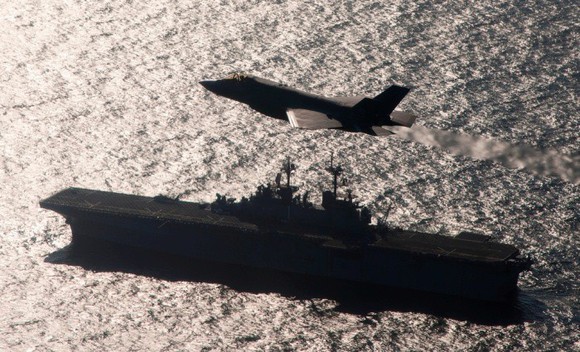Late last year, the then-president elect blasted Lockheed Martin (NYSE:LMT) for charging taxpayers a "tremendous cost" for its F-35 stealth fighter jet. At the time, Lockheed Martin's cheapest F-35 variant, the F-35A conventional takeoff-and-landing (CTOL) fighter jet, cost about $100 million each -- significantly more than fourth-generation fighter jets built by Boeing(NYSE:BA).
And so Trump tweeted that, if Lockheed Martin didn't move quickly to cut the cost of the F-35, he would "price-out a comparable F-18 Super Hornet" from Boeing (NYSE:BA) and buy that instead. (At the time, Boeing F/A-18 Super Hornets were selling for closer to $70 million, and a new Advanced Super Hornet was in the works that would eventually be priced at about $79 million.)
F-35 prices have been plummeting ever since.

F-35 PRICES JUST GOT CHEAPER -- BUT WHAT KIND OF F-35, EXACTLY? IMAGE SOURCE: LOCKHEED MARTIN.
Message received
Case in point: Last week, the U.S. Department of Defense announced in its daily digest of defense deals that it has awarded Lockheed Martin a $5.58 billion contract to supply the U.S. Air Force, Navy, and Marine Corps with a grand total of 74 new F-35 fighter jets. Specifically, Lockheed Martin will be delivering:
- 48 F-35A aircraft to the Air Force,
- 18 F-35B aircraft to the Marine Corps,
- and eight F-35C aircraft to be split between the Navy and Marine Corps.
Now, $5.58 billion probably sounds like a lot of money (because it is). But here's the crucial fact to keep in mind: At the time President Trump made his infamous F-35 tweet, Lockheed Martin was selling F-35A CTOL fighters for about $100 million apiece. (F-35B short takeoff-and-vertical landing (STOVL) fighters, and F-35C carrier variants cost much, much more).
Responding to President Trump's criticism, however, and helped by economies of scale as it ramped up production, Lockheed had already worked down the price of an F-35A to just $94.6 million by early this year. Granted, F-35Cs were still costing nearly $122 million a pop, and F-35Bs nearly $123 million -- but even so, the price for all F-35 variants was coming down rapidly, and moving in the right direction.
By June, we heard that the price had fallen even farther, with Lockheed rumored to have inked an 3-year, 11-nation, $40 billion deal to sell as many as 440 F-35 fighter jets (mainly F-35As) to the Pentagon and American allies for prices as low as $80 million. This latest Defense Department purchase shows that F-35s have become even cheaper than that -- and ahead of schedule.
Military math
Here's how the math works: $5.58 billion in spending to acquire 74 F-35s works out to an average price of just $75.4 million per fighter. That's even cheaper than the $80 million unit price that was mooted last month. It's also cheaper than the $79 million unit price that Boeing floated as the likely cost of its new Advanced Super Hornet earlier this year.
Even more amazing, more than one third of the F-35s the Pentagon will be buying are of the -B and -C variants -- which at last report each cost roughly 30% more than an F-35A. This suggests either that F-35Bs and -Cs are now approaching the lower cost of cheaper F-35As -- or that the F-35A itself may now cost even less than $75.4 million.
What it means to investors
Assuming the $5.58 billion price holds firm (F-35 Joint Program Office spokesman Joe DellaVedova says that the final price for Low Rate Initial Production Lot 11, containing the 74 planes in question, is still being negotiated), this new and improved F-35 price appears to weaken Boeing's argument for the Pentagon buying F/A-18 fighter jets as a cheaper alternative to Lockheed's F-35. So what does this mean for investors in Boeing and Lockheed?
Well, it's probably not great news for Boeing, but it doesn't mean all hope is lost. Boeing just succeeded in securing a commitment from Navy to fund development of its Advanced Super Hornet, after all. And even if Lockheed's F-35A variant is now price competitive with Boeing's F/A-18, F-35As still can't land on aircraft carriers. Meanwhile, F-35Cs -- which can land on carriers -- probably still cost more than F/A-18s.
That said, the lower F-35 prices fall, the smaller Boeing's price advantage shrinks. If this trend of falling F-35 prices keeps moving the way it's been going, Lockheed could win this contest yet -- and push Boeing out of the fighter jet business for good.
10 stocks we like better than Boeing
When investing geniuses David and Tom Gardner have a stock tip, it can pay to listen. After all, the newsletter they have run for over a decade, Motley Fool Stock Advisor, has tripled the market.*
David and Tom just revealed what they believe are the ten best stocks for investors to buy right now… and Boeing wasn't one of them! That's right -- they think these 10 stocks are even better buys.


































